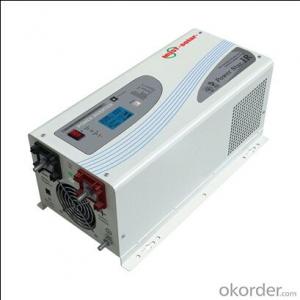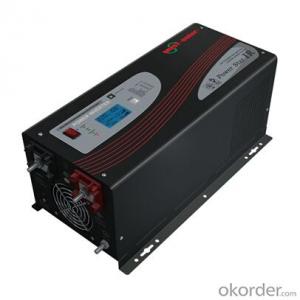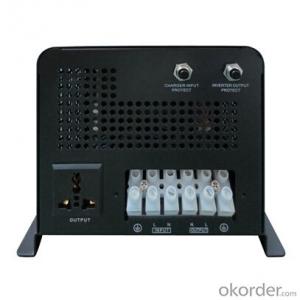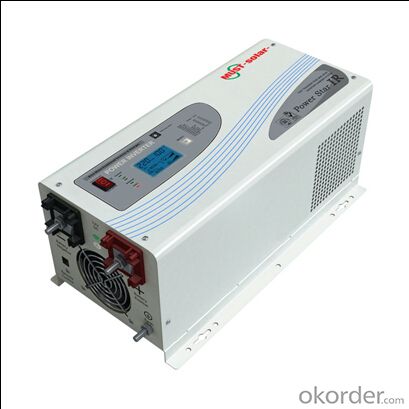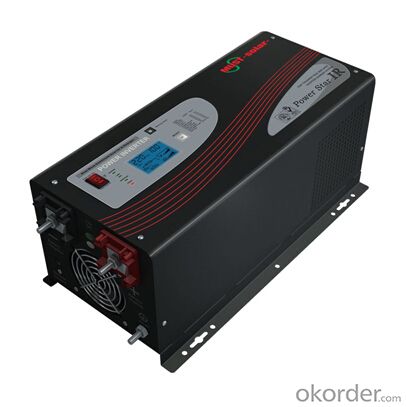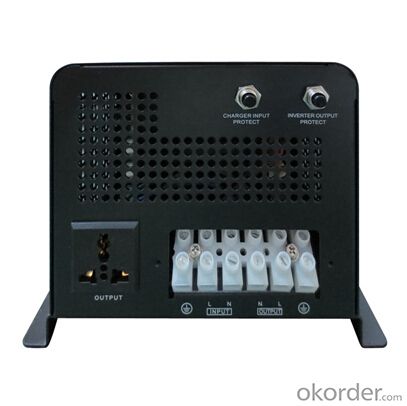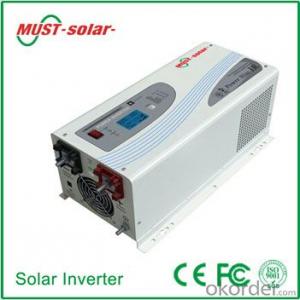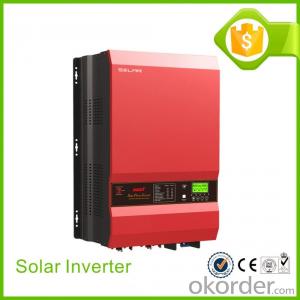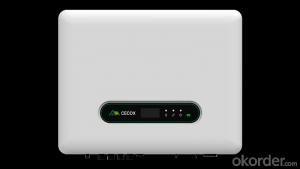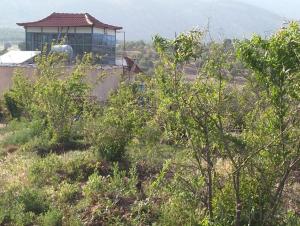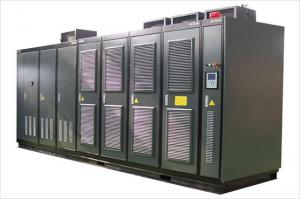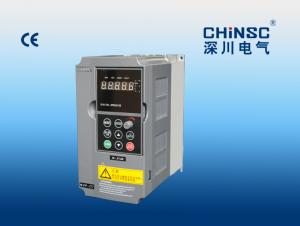4.2 Kw Off-Grid Low Frequency PV Inverter EP3200 Series 1Kw-3Kw
- Loading Port:
- China main port
- Payment Terms:
- TT or LC
- Min Order Qty:
- 30000 watt
- Supply Capability:
- 18000000 watt/month
OKorder Service Pledge
OKorder Financial Service
You Might Also Like
1. Structure of Off-Grid Low Frequency PV Inverter Description
A solar inverter, or PV inverter, or Solar converter, converts the variable direct current (DC) output of a photovoltaic (PV) solar panel into a
utility frequency alternating current (AC) that can be fed into a commercial electrical grid or used by a local, off-grid electrical network. It is a
critical BOS–component in a photovoltaic system, allowing the use of ordinary AC-powered equipment. Solar inverters have special
functions adapted for use with photovoltaic arrays, including maximum power point tracking and anti-islanding protection..
2. Main Features of the Off-Grid Low Frequency PV Inverter
• High overload ability of our EP3200 charger is up to 300% rated power
• EP3200 pure sine wave inverter adopts low quiescent current, and power saver mode to reduce power consumption to 3W
• It can extract max• power from various batteries with different protections, and low voltage trip can be selected (10V/10. 5V/11V)
• Uses PFC (power factor correction) for charger, which has less power consumption than conventional units.
• It has 10s delay before transfer when AC resumes, and overload protection when our APC pure sine wave inverter equips with generator
• 10ms typical transfer time between battery and AC, which guarantees power continuity of EP3200 charger. Uses selectable input AC
voltage (185-265V or 155-255V) for different kinds of loads
• Our EP3200 charger allows start up and through power with depleted batteries. Its powerful charge rate up to 70Amp
• It can offer 3-step intelligent battery charging, and equipped with 6 preset battery type selector for totally flat batteries
• LCD status display, battery/AC priority switch, RS232 communication port are available for our EP3200 pure sine wave inverter, it also has
17 alarms/warnings for easier operation and trouble-shooting, and ability to switch the unit on/off. In addition, select/deselect power saver
mode can be used too
3. Off-Grid Low Frequency PV Inverter Images
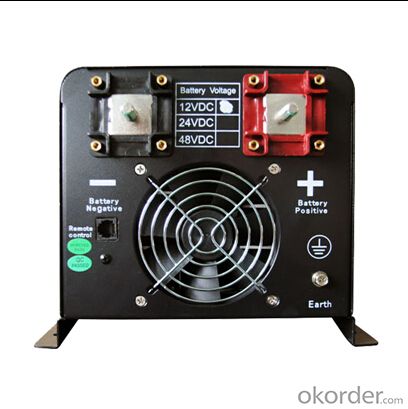
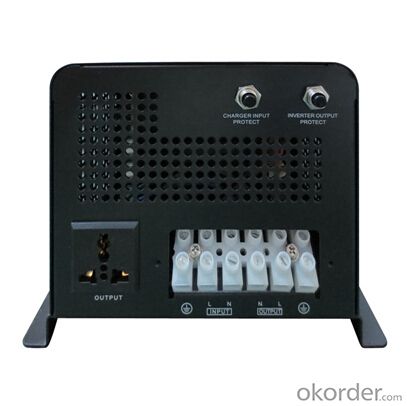
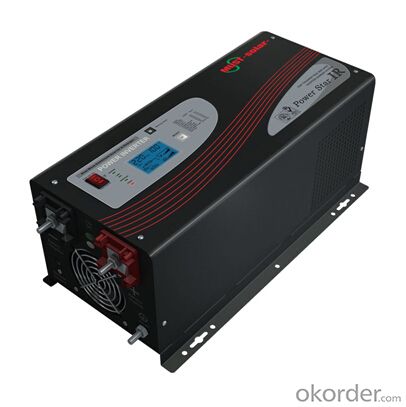
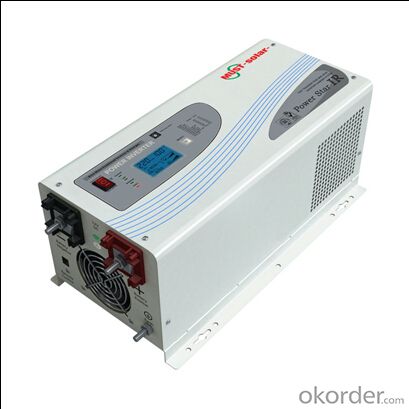
4. Off-Grid Low Frequency PV Inverter Specification
Rated Capacity | 1000W | 1500W | 2000W | 3000W |
Efficiency | >90% | |||
Input | ||||
Model | 120v Models | 230v Models | ||
Nominal Voltage | 100V/110V/115V/120V Selectable | 200V/220V/230V/240V Selectable | ||
Output | ||||
Rated Power | 1000W | 1500W | 2000W | 3000W |
Output Voltage | 100V/110V/115V/120V Selectable | 200V/220V/230V/240V Selectable | ||
Voltage Waveform | Pure Sine Wave | |||
Crest Factor | 3:01 | |||
Regulation(Nominal) | ±10% Typical Of Nominal Voltage | |||
Transfer Time | Transfer Time : AC To DC : 10ms (Typical) | |||
Transfer Time : DC To AC : 10ms(Typical ) | ||||
Max Bypass Overload Current | 30A | |||
Input | ||||
Nominal Voltage | DC12V/24V | DC12V/24V | DC12V/24V | DC24V/48V |
Over Current Protection | By Re-Settable Over Current Protector | |||
Output | ||||
Nominal Input Voltage | 230Vac | |||
Input Voltage Range | 185~265Vac | |||
Nominal Charge Current | 35amp-70amp | |||
Charger Short | Circuit Breaker | |||
Circuit Protection | ||||
Over Charge | Bat• V ≥ 15• 7Vdc/31• 4Vdc/62• 8Vdc | |||
Protection | Beeps 0• 5s Every 1s & Fault After 60s | |||
Battery Type | Lead-Acid 12Ah ~ 250Ah | |||
Typical Backup Time | No Limit, Depend on external battery | |||
Average Charging Current | 35A/20A | 45A/30A | 65A/35A | 75A/30A |
Battery voltage Option | ||||
Options 7 | Battery low trip to bypass 11v , high trip to battery 14v | |||
Options 8 | Battery low trip to bypass 10• 5v , high trip to battery 13• 5v | |||
Options 9 | Battery low trip to bypass 10v , high trip to battery 13v | |||
Communications & Management | ||||
Control Panel | LCD/LED Option | |||
Audible Alarm | Alarm On Battery:Low Battery & Battery Over Voltage | |||
Alarm On Abnormal Operation: | ||||
Over Load, Short-Circuit, & Over Heat | ||||
Environment and Safe | ||||
Operating Temperature | 0℃ To 40℃ (32℉ To 104℉) | |||
Transit/Storage Temperature | -15℃ To 60℃ | |||
Audible Noise | 60 Dba Max at 1m | |||
Quality Control System | ISO 9001,CE,FCC | |||
Physical | ||||
Dimensions: (H×D×W) | 570*320*315mm | |||
G• W (Kg) | 19 | 19 | 22.5 | 27.5 |
Packing | Export Carton For Each Unit Per Carton | |||
5. FAQ of Off-Grid Low Frequency PV Inverter
Q1 What is the difference between inverter and Off-Grid Low Frequency PV Inverter?
A1Inverter only has AC inpput, but Off-Grid Low Frequency PV Inverter both connect to AC input and solar panel, it saves more power.
Q2 What is the difference between MPPT&PWM?
A2MPPT has higher efficiency, it can track the max power point and won't waste energy.
Q3 What is the waranty of product?
A3 12 months.
- Q: Can a solar inverter be used for off-grid systems?
- Yes, a solar inverter can be used for off-grid systems. In fact, it is an essential component of off-grid solar systems as it converts the DC (direct current) electricity generated by the solar panels into AC (alternating current) electricity that can be used to power household appliances and other electrical devices.
- Q: What is the role of a surge protector in a solar inverter?
- The role of a surge protector in a solar inverter is to safeguard the inverter and connected electrical equipment from voltage spikes and power surges that can occur due to lightning strikes, grid fluctuations, or other electrical disturbances. It helps to prevent damage to the inverter and ensures the stability and longevity of the solar power system.
- Q: Are there any electromagnetic interference concerns associated with solar inverters?
- Yes, there are electromagnetic interference (EMI) concerns associated with solar inverters. Solar inverters convert the direct current (DC) generated by solar panels into alternating current (AC) that can be used to power homes and businesses. During this conversion process, high frequency switching occurs, which can generate EMI. EMI refers to the disturbance caused by electromagnetic radiation from electronic devices, which can interfere with the proper functioning of other electronic devices in close proximity. In the case of solar inverters, the EMI generated can potentially affect nearby electronic equipment, such as radios, televisions, or communication systems. To mitigate these concerns, solar inverter manufacturers often comply with relevant EMI standards and regulations. These may include limits on the amount of electromagnetic radiation emitted by the inverters and the use of shielding materials to reduce EMI. Additionally, some inverters incorporate filters or other EMI suppression techniques to minimize the interference created. It is important for solar installers and system designers to consider EMI concerns when selecting and positioning solar inverters. Proper installation and grounding techniques can help reduce EMI issues. Additionally, local regulations and guidelines should be followed to ensure compliance with EMI standards and to minimize potential interference with other electronic devices. Overall, while there are EMI concerns associated with solar inverters, proper design, installation, and adherence to relevant standards can effectively mitigate these concerns and ensure the smooth operation of both the solar system and other electronic equipment in the vicinity.
- Q: What are the potential risks of overheating a solar inverter?
- The potential risks of overheating a solar inverter include reduced efficiency and performance, increased wear and tear on components, shortened lifespan of the inverter, potential damage to internal circuitry, and even the risk of fire.
- Q: What are the signs of a faulty solar inverter?
- Some signs of a faulty solar inverter include a complete lack of power generation, inconsistent or fluctuating power output, error messages or fault codes displayed on the inverter, unusual or excessive noise coming from the inverter, and visual indicators such as flickering lights or abnormal behavior of connected devices.
- Q: How does a microinverter differ from a string inverter?
- A microinverter differs from a string inverter in that it is a small, individual inverter that is connected to each solar panel in a system, whereas a string inverter is a larger inverter that is connected to multiple panels in a series (string). This means that each panel with a microinverter can operate independently, optimizing the power output of each panel, while a string inverter operates based on the performance of the entire string of panels. Microinverters also allow for easier monitoring and maintenance as the performance of each panel can be individually tracked, whereas with a string inverter, any issues affecting one panel can impact the output of the entire string.
- Q: What are the key considerations for selecting a reliable solar inverter manufacturer?
- When selecting a reliable solar inverter manufacturer, key considerations include the manufacturer's reputation and experience in the industry, the quality and reliability of their products, the efficiency and performance of their inverters, the warranty and after-sales support provided, the compatibility of their inverters with your specific solar system requirements, and the manufacturer's financial stability and longevity in the market. Additionally, checking customer reviews and feedback can provide valuable insights into the manufacturer's track record and customer satisfaction.
- Q: How does a solar inverter handle voltage fluctuations during grid disturbances?
- A solar inverter handles voltage fluctuations during grid disturbances by constantly monitoring the grid voltage. When it detects a fluctuation or disturbance, it adjusts its own output voltage accordingly to stabilize the power supply. This is done through advanced control algorithms that regulate the inverter's power conversion process, ensuring a stable and consistent voltage output despite grid instabilities.
- Q: What is the maximum DC input voltage for a solar inverter?
- The maximum DC input voltage for a solar inverter typically depends on the specific model and manufacturer. However, in general, most solar inverters have a maximum DC input voltage ranging from 600 to 1000 volts.
- Q: How does a solar inverter handle voltage flicker in the grid?
- A solar inverter handles voltage flicker in the grid by continuously monitoring the grid voltage and adjusting its output accordingly. It uses various control algorithms to regulate the power output and stabilize the voltage, hence minimizing the impact of voltage flicker on the grid.
Send your message to us
4.2 Kw Off-Grid Low Frequency PV Inverter EP3200 Series 1Kw-3Kw
- Loading Port:
- China main port
- Payment Terms:
- TT or LC
- Min Order Qty:
- 30000 watt
- Supply Capability:
- 18000000 watt/month
OKorder Service Pledge
OKorder Financial Service
Similar products
Hot products
Hot Searches
Related keywords
